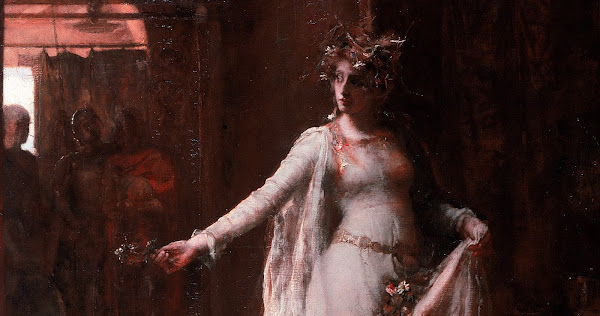Part 25: Ophelia's Self-Catching Conscience in the Mirror of her Arts
Unlike Claudius, who ignored qualms of conscience to murder his brother and usurp the throne, Ophelia’s relationship to her conscience is more healthy, rich, and self-directed.
Claudius just doesn’t get it, so he needs Hamlet to catch his conscience in The Mousetrap, [1] which reenacts Claudius poisoning his brother and wooing his victim’s wife. Hamlet says playing holds a mirror up to the age [2], and he uses the playlet to hold a mirror up to Gertrude and Claudius, showing what they’ve done.
But Ophelia gets it, and doesn’t need someone to hold up a mirror for her conscience. She chooses her own songs, stories, and allusions to reflect upon her sadness and conscience. [3]
She knows her father died, but doesn’t know that Hamlet killed him thinking it was Claudius. She sings songs of mourning for perhaps her father and/or the dead king [4], songs of her own choosing.
Ophelia knows Hamlet made to her “almost all the holy vows of heaven” [5] perhaps the equivalent of a handfast wedding, valid in Norway in Shakespeare’s lifetime [6]. She had rejected Hamlet in obedience to her father [7], and in turn, Hamlet rejected her [8]. After her father’s death, perhaps there is no longer a barrier to her relationship with the prince, and to Hamlet fulfilling his vows to her.
But Hamlet is on a sea voyage, and perhaps Ophelia realizes she is pregnant with his child (or figuratively pregnant with wishful thinking?). So she sings a Valentine song about an unfaithful lover who promised marriage but did not keep his promise [9], a song of her own choosing.
When Ophelia says, “They say the owl was a baker’s daughter” [10], she references a folktale retelling of the gospel tale of the Rich Man and Lazarus; but instead of a rich man, it is the baker’s daughter who is ungenerous with a beggar. Ophelia seems to be catching her own conscience for having obeyed her father and rejected Hamlet, who had begged for her love [11].
She says, “God be at your table” [12], a reference to the two disciples who recognize Jesus at table in the person of a stranger, rather than rejecting the stranger like the rich man or baker’s daughter. Better to welcome the stranger than neglect the beggar.
She knows her brother and father had made her feel that she and Hamlet were not a good match [13], like the false steward who stole his master’s daughter [14] in a Ben Jonson play subplot in Shakespeare’s time.
She distributes flowers and herbs, each with meanings, to catch the consciences of members of the court [15].
Ophelia had witnessed Hamlet’s use of the playlet to catch the consciences of Gertrude and Claudius [16], but in 4.5, she improves on Hamlet’s instruction, catching her own conscience and those of the court in the arts of song and story.
~~~~~
NOTES: All references to Hamlet are to the Folger Shakespeare Library online version: https://shakespeare.folger.edu/shakespeares-works/hamlet/entire-play/
[1] HAMLET: The play’s the thing / Wherein I’ll catch the conscience of the King. (2.2.663-4)
[2] …the purpose
of playing, whose end, both at the first and
now, was and is to hold, as ’twere, the mirror up to
nature, to show virtue her own feature, scorn her
own image, and the very age and body of the time
his form and pressure.
(3.2.21-26)
[3] 4.5.26-78, 188-224.
[4] 4.5.34-37, 88-91, 94-95, 213-222.
[5] 1.3.123.
[6] James Heburn, 4th Earl of Bothwell, had made a “handfast” marriage with Anna Throndsen, recognized as valid in Norway but not in Scotland or England. He was later suspected of playing a key role in the murder of Henry Lord Darnley, husband of Mary, Queen of Scots, and also married her.
See previous post, FN 7:
https://pauladrianfried.blogspot.com/2023/11/part-24-ophelia-gertrude-and-shifting.html
[7] POLONIUS: This is for all:
I would not, in plain terms, from this time forth
Have you so slander any moment leisure
As to give words or talk with the Lord Hamlet.
Look to ’t, I charge you. Come your ways.
OPHELIA I shall obey, my lord.
(1.3.140-145)
[8] 3.1.105-162.
[9] 4.5.53-71.
[10] 4.5.47.
[11] See Hamlet’s letters to Ophelia, 2.2.117-130.
[12] 4.5.49.
[13] 1.3.6-48, 95-144.
[14] 4.5.196-197.
[15] 4.5.199-209.
[16] 3.2.116-196.
IMAGE:
Ophelia, 1890, Henrietta Rae (1859–1928), detail, public domain via
https://commons.wikimedia.org/wiki/File:Henrietta_Rae_-_Ophelia_-_Google_Art_Project.jpg
~~~~~~~~~~~~~~~~~~~~~~~~~~~~~~~
~~~~~~~~~~~~~~~~~~~~~~~~~~~~~~~
INDEX OF OPHELIA POSTS:
My 2023 series on Ophelia, and earlier Ophelia posts:
https://pauladrianfried.blogspot.com/2023/10/index-of-ophelia-posts-2023-series-and.html
~~~~~~~~~~~~~~~~~~~~~~~~~~~~~~~
~~~~~~~~~~~~~~~~~~~~~~~~~~~~~~~
YOU CAN SUPPORT ME on a one-time "tip" basis on Ko-Fi:
https://ko-fi.com/pauladrianfried
IF YOU WOULD PREFER to support me on a REGULAR basis,
you may do so on Ko-Fi, or here on Patreon:
https://patreon.com/PaulAdrianFried
~~~~~~~~~~~~~~~~~~~~~~~~~~~~~~~
~~~~~~~~~~~~~~~~~~~~~~~~~~~~~~~
Disclaimer: If and when I quote or paraphrase bible passages or mention religion in many of my blog posts, I do not intend to promote any religion over another, nor am I attempting to promote religious belief in general; only to explore how the Bible and religion influenced Shakespeare, his plays, and his age.
~~~~~~~~~~~~~~~~~~~~~~~~~~~~~~~~~~~~~~
~~~~~~~~~~~~~~~~~~~~~~~~~~~~~~~~~~~~~~
Thanks for reading!
~~~~~~~~~~~~~~~~~~~~~~~~~~~~~~~~~~~~~~
~~~~~~~~~~~~~~~~~~~~~~~~~~~~~~~~~~~~~~
My current project is a book tentatively titled Hamlet’s Bible, about biblical allusions and plot echoes in Hamlet.
Below is a link to a list of some of my top posts (“greatest hits”), including a description of my book project (last item on the list):
https://pauladrianfried.blogspot.com/2019/12/top-20-hamlet-bible-posts.html
I post every week, so please visit as often as you like and consider FOLLOWING.
To find the FOLLOW button, go to the home page: https://pauladrianfried.blogspot.com/
see the = drop-down menu with three lines in the upper left.
From there you can click FOLLOW and see options.


Comments
Post a Comment